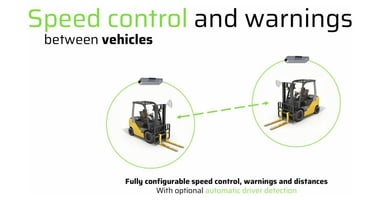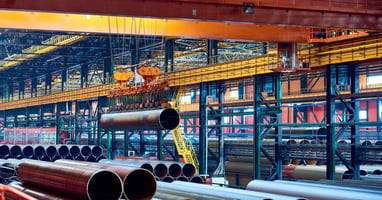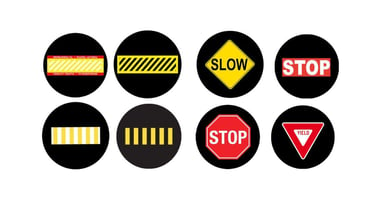To keep supply chains moving, warehouse operations must be efficient. Efficiency goes hand in hand...
The Repercussions of Pedestrian Accidents in a Warehouse

Pedestrian accidents in warehouses are more common than most people think. These incidents can cause serious injuries and lead to significant operational disruptions. By utilizing Logimate’s solutions and understanding the repercussions of pedestrian accidents, you can create a safe environment for everyone in or near a warehouse.
Common Types of Pedestrian Accidents
Understanding the types of pedestrian accidents that commonly occur in warehouses can help in devising effective prevention strategies. The most frequent types include forklift collisions, trips and falls, and incidents involving falling objects.
Forklift collisions often happen due to blind spots, while trips and falls usually result from cluttered walkways or uneven flooring. Falling object accidents can occur when items are not properly stored or secured at height. Other incidents can occur because of a lack of training as well. The impact on the victim can range from minor injuries to life-threatening conditions.
The Financial Repercussions
When a pedestrian accident occurs, the financial implications can be severe. Companies may face hefty fines for failing to adhere to safety regulations.
Additionally, there are costs associated with medical treatment, legal fees, and potential settlements. These expenses can strain a company’s budget and affect its bottom line.
Disruption to Operations
An accident doesn't just affect the injured worker; it disrupts the entire workflow. When an accident occurs, investigations and safety audits can bring operations to a halt.
This downtime can lead to missed deadlines and dissatisfied customers, affecting the business's reputation.
Brand and Reputation Damage
In today’s information-driven world, accidents can easily attract public and media attention, especially if they result in severe injuries or fatalities. Negative publicity can tarnish a company’s reputation, leading to a loss of consumer trust and potential business opportunities. Companies known for unsafe working conditions may find it challenging to attract and retain both customers and employees.
Impact on Employee Morale
A safe working environment is also essential for maintaining high employee morale. When accidents happen, it can lead to fear and anxiety among workers. This emotional toll can result in decreased productivity and increased turnover rates, further impacting the company's efficiency.
Legal Consequences
Ignoring warehouse safety can lead to severe legal consequences. Companies may face lawsuits from injured workers or their families. Regulatory bodies may also impose penalties for non-compliance with safety standards. These legal battles can be lengthy and costly.
The Importance of Safety Training
One of the most effective ways to prevent pedestrian accidents is through comprehensive safety training. Employees need to be aware of the potential hazards and how to avoid them. Regular training sessions can ensure that safety protocols are fresh in everyone’s minds.
Implementing Safety Measures

Safety measures, such as clearly marked pedestrian zones and appropriate signage, can significantly reduce the risk of accidents. Installing barriers and guardrails can also help keep pedestrians safe from moving vehicles.
Addressing the Human Factor
Human error is one of the leading causes of pedestrian accidents in warehouses. Addressing this requires a multifaceted approach, including thorough training, regular performance evaluations, and fostering a culture of accountability. Encouraging employees to speak up about safety concerns and near-misses can also help in identifying and rectifying potential hazards before they result in accidents.
Encouraging a Proactive Safety Approach
Encouraging employees to take a proactive approach to safety can make a significant difference. This approach involves not just following safety protocols but actively looking for potential hazards and suggesting improvements. Recognizing and rewarding proactive safety behaviors can help in cultivating a vigilant and safety-conscious workforce.
Government Regulations and Compliance
Adhering to government regulations is not just a legal obligation but also a fundamental aspect of maintaining warehouse safety. Regulations such as the Occupational Safety and Health Administration (OSHA) guidelines provide a framework for creating a safe working environment. Regular compliance audits can help ensure that all safety measures are up to date and effective.
Seasonal Safety Considerations
Different seasons bring different safety challenges. For instance, winter may introduce hazards like icy walkways and poor visibility, while summer can pose risks related to heat exhaustion. Being aware of these seasonal dangers and preparing accordingly can help maintain a safe workplace year-round. This preparation can include seasonal training sessions and updating safety equipment as needed.
The Role of Technology

Technology can play a vital role in enhancing warehouse safety. For instance, a forklift proximity sensor found at Logimate can alert drivers and pedestrians when they are too close to each other. These sensors can drastically reduce the likelihood of accidents.
Industry-Specific Challenges
Different industries face unique challenges when it comes to warehouse safety. For example, the healthcare industry may deal with hazardous materials, while the logistics sector often involves high-speed operations. Understanding these nuances is essential for implementing effective safety protocols.
Long-Term Benefits of Safety Investments
Investing in safety measures may seem costly upfront, but the long-term benefits are substantial. Reduced accident rates lead to lower insurance premiums, fewer legal issues, and a more productive workforce. These savings can far outweigh the initial investment.
Building a Safety Culture
Creating a culture of safety involves more than just implementing rules and regulations. It requires commitment from all levels of the organization. When everyone prioritizes safety, it becomes ingrained in the company’s ethos, leading to a safer working environment.
Employee Involvement in Safety Planning
Involving employees in safety planning can yield better results. They are the ones on the ground and can provide valuable insights into potential hazards. Encouraging them to participate in safety committees or suggestion programs can help identify and mitigate risks more effectively.
The Future of Warehouse Safety
The future of warehouse safety looks promising with advancements in technology and a greater focus on employee well-being. Innovations like floor lasers, automated vehicles and AI-driven safety protocols are set to revolutionize how warehouses operate, making them safer for everyone involved.
Pedestrian accidents in warehouses have far-reaching repercussions. From financial losses to operational disruptions and legal consequences, the impact can be devastating. However, by investing in preventative measures, companies can create a safer working environment. Prioritizing safety not only protects employees but also enhances overall business performance.
For more insights and expert advice, consider booking a consultation with our safety specialists at Logimate! Your commitment to safety can make all the difference.




